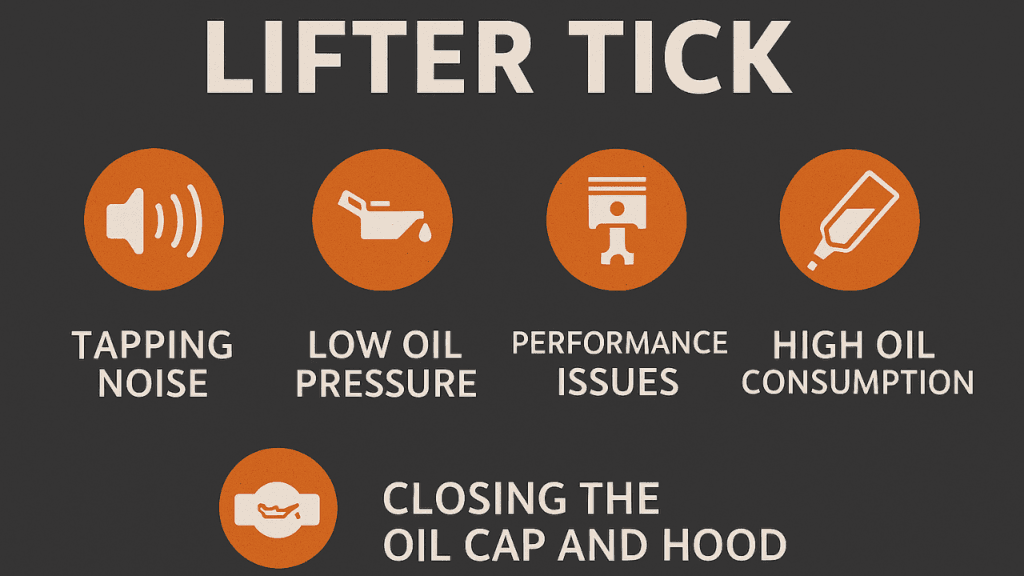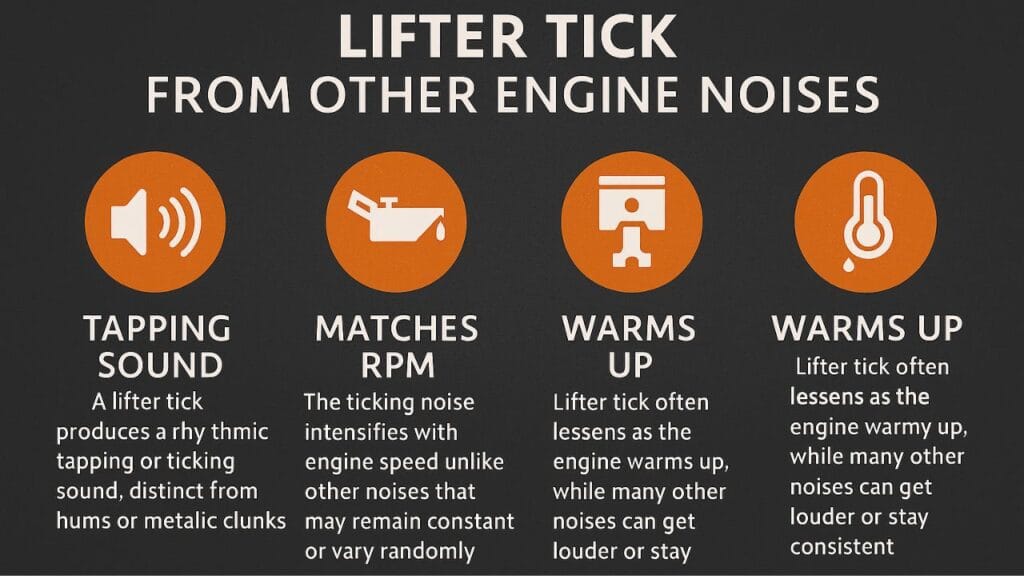Lucas Heavy Duty Oil Stabilizer mitigates lifter tick by advancing oil film strength, stabilizing viscosity under heat, and upgrading hydraulic lifter function. It reduces metal-to-metal contact, restores oil pressure in worn components, and promotes quieter valvetrain operation—making it a trusted additive for high-mileage or noisy engines.
Understanding Lifter Tick: Causes and Symptoms

Lifter tick is a repetitive tapping sound caused by inadequate oil flow, worn hydraulic lifters, or sludge buildup. It intensifies with engine RPM and is common during cold starts or after delayed oil changes. Prompt diagnosis and proper lubrication are key to preventing long-term engine wear.
What Is Lifter Tick?
Lifter tick is a soft, Constant tapping sound you hear from the engine, usually caused by worn hydraulic lifters or poor oil circulation. It often shows up during cold starts or when oil pressure drops. If ignored, it can lead to bigger engine problems over time.
The Root Causes of Lifter Tick
Lifter tick stems from poor oil circulation, worn hydraulic lifters, or sludge buildup in the valvetrain. Contributing factors include low oil pressure, incorrect oil viscosity, and infrequent maintenance. These conditions disrupt lifter function, producing rhythmic ticking during engine operation.
How to Differentiate Lifter Tick from Other Engine Noises?

Lifter tick produces a light, rhythmic tapping that rises with engine RPM. Unlike deeper knocking or erratic clattering, it’s consistent and valve-train specific. It often appears during cold starts and fades as oil pressure stabilizes with engine warmth.
Lucas Oil Stabilizer: What It Is and How It Works?
Lucas Oil Stabilizer is a petroleum-based additive that enhances engine protection by forming a durable lubricating film between metal surfaces. It reduces friction, improves oil pressure, and slows wear in aging engines. Used during oil changes, it helps maintain viscosity, reduce noise, and extend oil life.
Does Lucas Oil Stabilizer Really Fix Lifter Tick? Pros, Cons, and User Reviews
Lucas Oil Stabilizer may reduce lifter tick by improving oil viscosity and pressure, especially in older or high-mileage engines. Users report smoother operation and reduced noise, though results vary. It’s not a permanent fix—damaged lifters require mechanical repair. Best used as a preventive or temporary aid during oil changes.
Step-by-Step Guide: How to Use Lucas Oil Stabilizer for Lifter Tick
To use Lucas Oil Stabilizer for lifter tick, check oil condition, and change if dirty. Add 20-25% stabilizer to the crankcase during an oil change. Run the engine for 10-15 minutes. Monitor noise after 200-500 miles. Use 5W-30 oil for better flow. Consult a mechanic if the tick persists.
Preparation
Preparation involves warming up the engine, gathering tools, and ensuring the correct oil type and stabilizer ratio. Park on a level surface, wear gloves, and let the engine cool slightly before draining oil to avoid burns or spills.
Application Process
During an oil change, drain the old oil completely. Replace 20–25% of the total oil volume with Lucas Oil Stabilizer, then top off with the correct motor oil. Start the engine and let it idle for a few minutes to ensure full circulation. Monitor for reduced lifter noise.
Time to Results: What to Expect
Results from Lucas Oil Stabilizer typically emerge after several heat cycles. It reduces lifter tick by improving oil viscosity and pressure, but effectiveness depends on engine condition and the severity of internal wear.
Alternatives to Lucas Oil Stabilizer for Lifter Tick

Several additives offer alternatives to Lucas Oil Stabilizer for addressing lifter tick. Products like Liqui Moly Hydraulic Lifter Additive, Marvel Mystery Oil, and Sea Foam Motor Treatment improve lubrication, dissolve sludge, and restore lifter function. Effectiveness depends on engine wear and oil condition. Always match the additive to your engine’s needs and manufacturer guidelines.
Other Additives
Other oil additives designed to address lifter tick include Liqui Moly Hydraulic Lifter Additive, Marvel Mystery Oil, Sea Foam Motor Treatment, and Rislone Engine Treatment.
These products enhance lubrication, dissolve sludge, and restore hydraulic lifter performance. Selection depends on engine type, oil formulation, and the severity of internal wear.
Mechanical Fixes
Mechanical solutions for lifter tick involve inspecting and replacing worn hydraulic lifters, adjusting valve lash, or cleaning clogged oil passages. In severe cases, camshaft or pushrod replacement may be necessary.
These repairs restore proper valvetrain function and eliminate persistent ticking. Diagnosis should be performed by a qualified technician to ensure accurate repair and long-term Integrity.
Preventive Maintenance Tips
Regular oil changes using high-quality oil and filters help prevent lifter tick. Monitor oil levels and pressure frequently. Use engine-safe additives to maintain lubrication and reduce wear.
Avoid extended idling and cold starts without warm-up. Follow manufacturer service intervals for valve adjustments and inspections to ensure long-term valvetrain health and quiet operation.
Best additive for lifter tick
Liqui Moly Hydraulic Lifter Additive is widely recommended for fixing lifter tick. It’s designed to clean oil passages and restore lifter function. Other top picks include Hot Shot’s Secret Stiction Eliminator and Marvel Mystery Oil. These additives improve lubrication, reduce friction, and quiet noisy lifters—especially in older or high-mileage engines.
Frequently FAQ
Yes, Lucas Oil Stabilizer is fully compatible with synthetic oil. It enhances lubrication, reduces wear, and improves engine performance.
Lucas Oil Stabilizer won’t damage your engine if used correctly. Overuse may cause the oil to thicken excessively, affecting flow and cold starts. Always follow the recommended dosage.
Lucas Oil Stabilizer may reduce lifter tick within a few hours to several days of driving. Results depend on engine condition, oil flow, and the severity of lifter wear or blockage
Lucas Oil Stabilizer is an oil additive that enhances lubrication and reduces wear, while Lucas Fuel Treatment is a fuel additive that cleans injectors, improves combustion, and boosts engine efficiency.
High-quality synthetic oils with cleaning agents, like Mobil 1 or Royal Purple, often reduce lifter tick by improving lubrication and flow.
Before using Lucas Oil Stabilizer, engines may suffer from ticking, low oil pressure, or wear. After treatment, lubrication improves, lifter noise often decreases, and overall engine performance and protection are enhanced.
Conclusion
Lucas Oil Stabilizer can significantly reduce or eliminate lifter tick by improving oil viscosity, enhancing lubrication, and dissolving deposits that restrict lifter movement. Its effectiveness depends on engine age, wear level, and maintenance history. When used correctly, it not only quiets noisy lifters but also extends component life, stabilizes oil pressure, and supports long-term engine reliability.

